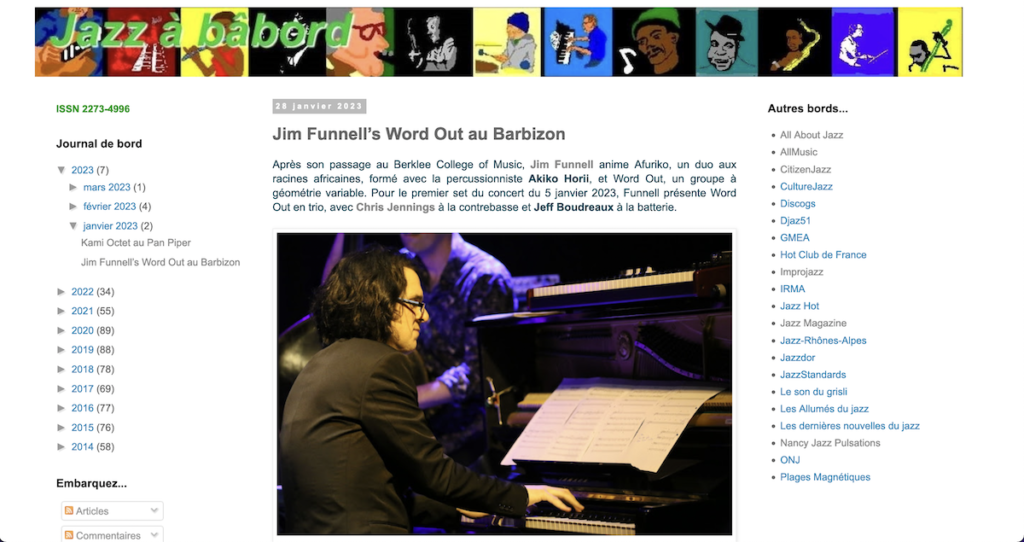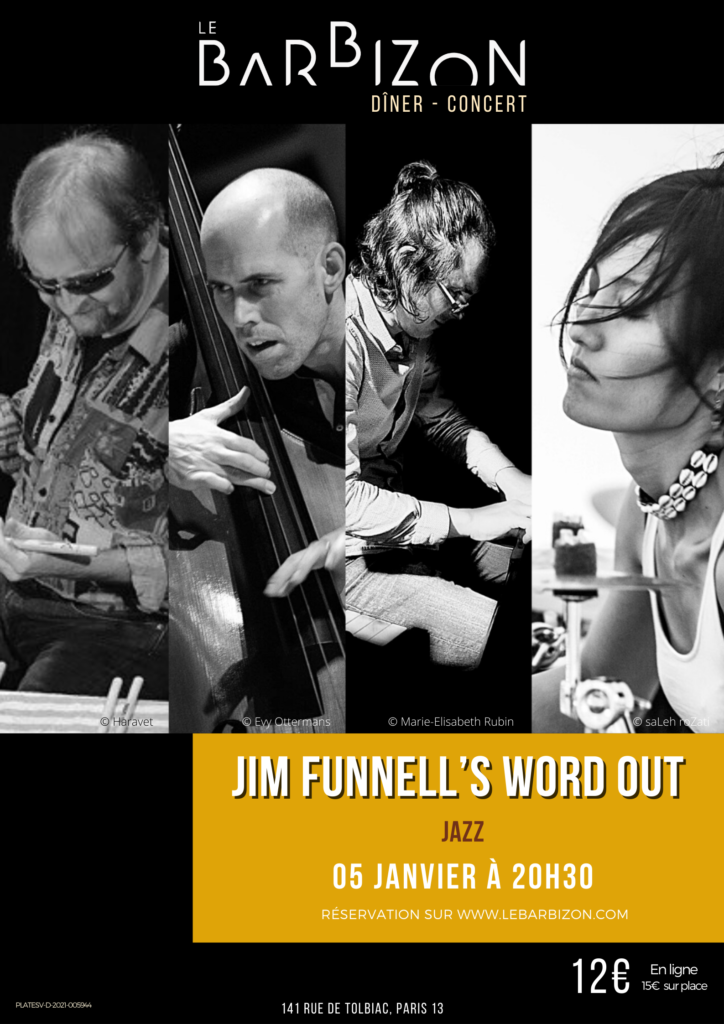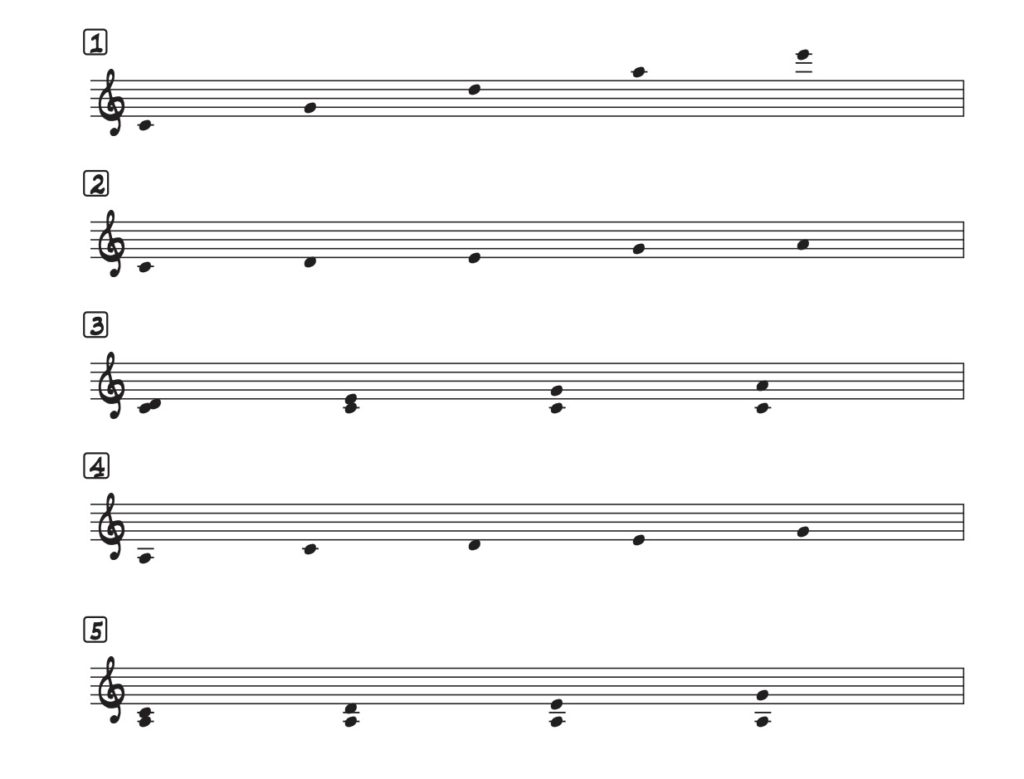
🇫🇷 “Jim Funnell’s Word Out mixe tradition et modernité dans un néo-bop mélodieux et enjoué.”
🇬🇧/🇺🇸 “Jim Funnell’s Word Out’s melodious and playful neo-bop blends tradition with modernity.”
Bob Hatteau, Jazz à bâbord

🇫🇷 “Jim Funnell’s Word Out mixe tradition et modernité dans un néo-bop mélodieux et enjoué.”
🇬🇧/🇺🇸 “Jim Funnell’s Word Out’s melodious and playful neo-bop blends tradition with modernity.”
Bob Hatteau, Jazz à bâbord

Tomek’s Ear Condition 598 – 2022.12.23, complete playlist:
1. THE SOUND THAT ENDS CREATION – Rudolph The Red Nosed Reindeer — Merry Christmas You Filthy Animal DL
2. ADAM NEELY – God Rest Ye Merry Gentlemen 17TET — Christmas Microtonal Lo-Fi Hip Hop DL
3. JIM FUNNELL’S WORD OUT – Bitcorn Soup (Alternate) — Bitcorn Soup DL
4. JIM FUNNELL’S WORD OUT – Lesser Vice — Lesser Vice DL
5. BJÖRK – Atopos — Fossora 2LP
6. MASS OF AMARA – Army Of Me — Army Of Me DL
7. VOIVOD – Ultraman — Ultraman EP
8. SIGH – Heresy I: Oblivium — Heir To Despair DL
9. ANCHOR AND BURDEN – Cerebral Transfixation — Kosmonautik Pilgrimage DL
10. PANZERBALLETT – Let It Snow — X-Mas Death Jazz 2LP
11. MICHAEL JEFRY STEVENS – Email — The Slope DL
12. ร็อกคงคย (ROCK KONG KOI) – รักมีพิษ (Rak Mi Pit) — เสียวโว๊ย (Sieow Woi) MC

🇬🇧/🇺🇸 Concert (with dinner or drinks): Word Out on January 5 from 8PM at Le Barbizon (141 rue de Tolbiac, 75013 Paris). Join us and experience a repertoire of new post-bop/ethno jazz fusion compositions. With Chris Jennings (double bass), Jeff Boudreaux (drums), Akiko Horii (percussion) and Jim Funnell (piano/compositions). RSVP available on Le Barbizon’s website here.
🇫🇷 Dîner-concert (ou juste pour prendre un verre) : Word Out le 5 janvier prochain à partir de 20h au Barbizon (141 rue de Tolbiac, 75013 Paris). Venez découvrir un tout nouveau répertoire composé de morceaux post-bop/ethno jazz fusion avec Chris Jennings (contrebasse), Jeff Boudreaux (batterie), Akiko Horii (percussions) et Jim Funnell (piano/compositions). Réservation possible dès aujourd’hui sur le site du Barbizon.
🇪🇸 Concierto (con cena o bebidas): Word Out el 5 de enero a partir de las 20h en Le Barbizon (141 rue de Tolbiac, 75013 París). Únase a nosotros y disfrute de un repertorio de nuevas composiciones de post-bop/ethno jazz fusión. Con Chris Jennings (contrabajo), Jeff Boudreaux (batería), Akiko Horii (percusión) y Jim Funnell (piano/composiciones). RSVP disponible en el sitio web de Le Barbizon aquí.
🇯🇵 コンサート(ディナーまたはドリンク付き)。
1月5日午後8時より、Le Barbizon (141 rue de Tolbiac, 75013 Paris)にてWord Outのライブを開催します。
新しいポストバップ/エスノジャズフュージョンのレパートリーをお聴き頂けます。
Chris Jennings (ダブルベース), Jeff Boudreaux (ドラム), 堀居晶子 (パーカッション) and Jim Funnell (ピアノ&作曲) 。
ル・バルビゾンのウェブサイトから参加登録が可能です。

“Une musique au surréalisme indomptable.” – Ravy Magnifique (batteur, compositeur, percussionniste)
🇬🇧/🇺🇸 Recorded in Paris, Boston, and London from August 2021 to March 2022. Mixed and mastered by Javier Escudero in April 2022 at Estudios Cubex (Spain). Artwork by Marie-Elisabeth Rubin (France). Video editing by Laure Lang.
🇫🇷 Enregistré à Paris, Boston, et à Londres entre août 2021 et Mars 2022. Mixé et masterisé par Javier Escudero en Avril 2022 à Estudios Cubex (Espagne). Art graphique par Marie-Elisabeth Rubin (France). Montage vidéo par Laure Lang.
David Fiuczynski (g)
Dominique Muzeau (b)
Franck Vaillant / Asaf Sirkis (d)
Ravy Magnifique (perc)
Akiko Horii (perc)
Jim Funnell (keys & composition)

🇬🇧 The Spotify Pre-Save campaign for Bitcorn Soup is now live, which means you can go ahead and unlock the music to make sure you don’t miss it on release day (September 10). You will get a notification from Spotify, and both microtonal jazz fusion tracks (a main and an alternate take) will be added to your Release Radar on the platform.
This also helps the music get featured on different playlists as pre-saves tell the Spotify algorithm that fans are excited about the release. So thank you in advance for the nudge, it is much appreciated!
🇫🇷 La campagne de pre-save (pré-enregistrement) Spotify pour le single Bitcorn Soup est en ligne, ce qui veut dire que tu peux désormais “déverrouiller” la musique, de façon à ne pas la rater le jour de sa sortie officielle (le 10 septembre). Tu recevras une notification de la part de Spotify, et les deux titres jazz fusion microtonal (une version principale du morceau ainsi qu’une version alternative) seront ajoutés à ton Radar des sorties.
Cela permet aussi d’augmenter les chances de voir cette musique selectionnée dans le cadre de diverses playlists : les “pre-save” permettent en effet de communiquer à l’algorithme de Spotify que les fans sont enthousiastes à l’idée de la sortie prochaine. Donc merci d’avance pour ton petit coup de pouce très apprécié !

Le terme “pentatonique” nous vient de la langue grecque : le préfixe penta-, “cinq”, et le mot tonos, “ton”, y sont associés pour évoquer l’idée d’une gamme à cinq notes.
Il existe bien entendu de nombreuses possibilités d’échelles de cinq sons au sein du système tempéré (division de l’octave en douze intervalles égaux, dits chromatiques). Nous porterons ici notre attention sur la gamme pentatonique la plus usitée et l’appellerons la pentatonique “globale”¹ (on retrouve en effet cette gamme dans les musiques de nombreuses cultures de par le monde).
[1] La pentatonique globale est fondée sur une succession de quintes ascendantes : do sol ré la mi.
[2] Une fois ces notes réarrangées au sein d’une seule octave, nous avons : do ré mi sol la.
[3] Les intervalles formés par les notes de cette gamme par rapport à sa fondamentale (do) sont :
Comme tous les intervalles de cette gamme sont majeurs (mis à part la quinte juste), elle est souvent baptisée pentatonique majeure. Ce que j’appelle sa “formule”, qui associe des chiffres arabes² à chacun de ses degrés (contrairement aux chiffres romains communément utilisés pour représenter les accords construits sur chacun des degrés d’une gamme), est la suite de nombres : 1 2 3 5 6.
[4] Exactement comme pour les échelles majeures diatoniques à sept sons (do ré mi fa sol la si), la gamme relative mineure de la pentatonique majeure se construit en jouant toutes les notes formant la pentatonique majeure, en partant une tierce mineure en dessous de la fondamentale de celle-ci : la do ré mi sol.
[5] Les intervalles formés par les notes de cette nouvelle gamme par rapport à sa fondamentale (la) sont :
Comme tous les intervalles de cette gamme sont mineurs (sauf la quarte et la quinte), elle est souvent appelée pentatonique mineure. Sa “formule” est : 1 b3 4 5 b7.
En résumé, voici les formules à savoir (accompagnées d’exemples ayant la note do pour tonique dans les deux cas pour faciliter la comparaison) :
| Pentatonique majeure | 1 2 3 5 6 | do ré mi sol la |
| Pentatonique mineure | 1 b3 4 5 b7 | do mib fa sol sib |
Notes
¹ Cette terminologie est utilisée par Michael Hewitt dans son livre Musical Scales of the World (voir Hewitt 2013).
² Plus exactement, il s’agit des chiffres communément utilisés en Europe qui nous viennent du système de numérotation indo-arabe.
Références
Hewitt, Michael. “Section 5: Pentatonic Scales.” Dans Musical Scales of the World, 125-134. The Note Tree, 2013.